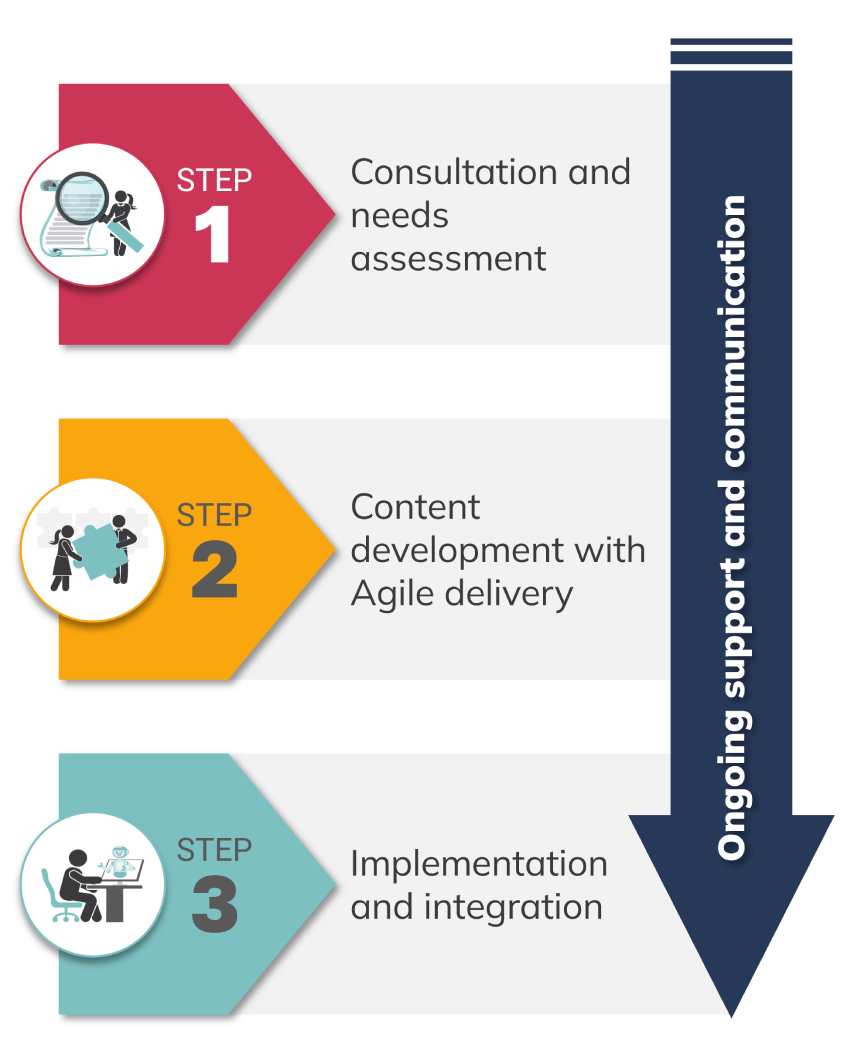Bespoke e-learning development for customised content
Bespoke e-learning development offers customised e-learning content. This approach focuses on tailored digital learning development, making learning and development more effective. Businesses can choose bespoke development, bespoke digital learning, or even bespoke e-learning services to fit their learning needs. Bespoke e-learning solutions and bespoke education development help create content that resonates with learners and brands.
Custom e-learning development and Learning Management Systems
Custom e-learning development involves the use of Learning Management Systems (LMS) and multimedia. It allows for e-learning customisation, such as SCORM-compliant courseware, rapid authoring, and mobile-learning. Bespoke elearning development includes gamification, microlearning, and simulations to make content engaging. Through bespoke instructional design, companies ensure e-learning content development aligns with brand identity.
Blended learning and virtual classroom solutions
Blended learning and virtual classroom solutions add flexibility to the learning environment. Projects are managed with input from subject matter experts and creative designers. This makes training content, including onboarding, compliance training, and soft skills development, accessible. Branding and logos can be included, and content can be delivered on any platform.
Bespoke educational development with engaging media
Bespoke educational development uses animations, graphics, and video to bring e-learning to life. The process offers customisation, allowing training content to be consistent with company policy and style. Learning Management System integration ensures easy access, tracking, and updates. Customised e-learning development supports both large and small teams, offering tailored learning development for every need.
Benefits of e-learning bespoke solutions
Clients benefit from high retention rates, engaging assessments, and relevant information. E-learning bespoke solutions are perfect for organisations who want a learning experience that fits their unique environment. The result is a personalised e-learning development process that covers every step, from initial storyboarding to final delivery.
Bespoke e-learning development: What is it and why is it important?
Bespoke e-learning development is the process of creating custom digital learning solutions tailored to an organisation’s goals, ensuring better learner engagement, skill development, and alignment with business objectives.
Bespoke e-learning development vs. off-the-shelf solutions: How do they differ?
Unlike off-the-shelf courses, bespoke e-learning development delivers customised learning experiences designed around specific training requirements, brand identity, and performance outcomes using flexible instructional design strategies.
Bespoke e-learning development: Which industries benefit the most?
Industries such as healthcare, finance, manufacturing, and education gain the most from bespoke e-learning development due to their need for compliance, scalability, and workforce skill improvement through tailored online training programs.
What are the key steps in the bespoke e-learning development process?
The bespoke e-learning development process typically involves needs analysis, storyboarding, content creation, Agile software development, multimedia integration, testing, and deployment through a Learning Management System.
How can bespoke e-learning development improve learner engagement?
Bespoke e-learning development enhances engagement by incorporating gamification, real-world scenarios, multimedia, and interactive modules that adapt to various learning styles and preferences.
What technologies are commonly used in bespoke e-learning development?
Technologies such as SCORM-compliant authoring tools, xAPI-enabled platforms, cloud-based LMS systems, and data analytics software are key components of effective bespoke e-learning development solutions.
What challenges might one face during bespoke e-learning development?
Common challenges include managing project timelines, maintaining stakeholder alignment, ensuring accessibility, and balancing creative design with technical limitations during bespoke e-learning development.
How do you measure the success of bespoke e-learning development projects?
Success in bespoke e-learning development is measured through learner feedback, assessment analytics, completion rates, and the overall impact on employee performance and organisational goals.
What role do subject matter experts play in bespoke e-learning development?
Subject matter experts collaborate with instructional designers and developers to ensure that bespoke e-learning development content is accurate, relevant, and aligned with real-world business needs.
How does bespoke e-learning development integrate with existing Learning Management Systems (LMS) and e-learning courses?
Bespoke e-learning development integrates seamlessly with existing LMS and e-learning courses through SCORM or xAPI standards, ensuring smooth data tracking, updates, and compatibility with corporate learning ecosystems.
What role do simulations and multimedia play in bespoke e-learning development for enhancing virtual classrooms?
Simulations, animations, and multimedia in bespoke e-learning development create immersive virtual classroom experiences that promote better knowledge retention and real-world application of learning.
How does bespoke e-learning development improve mobile learning and blended learning experiences?
Bespoke e-learning development supports mobile learning and blended learning models by delivering responsive, on-demand content that complements classroom sessions and supports learning anywhere.
In what ways can gamification and animations be incorporated into bespoke e-learning development?
Gamification and animations are used in bespoke e-learning development to drive motivation, enhance interactivity, and provide engaging feedback loops that reinforce key learning objectives.
How does bespoke e-learning development support the creation of personalised learning environments and courseware?
Bespoke e-learning development enables the creation of personalised learning paths and adaptive courseware that respond to learner performance, preferences, and career development goals.
What are the benefits of using storyboarding and graphics in bespoke e-learning development?
Storyboarding and visual design in bespoke e-learning development help structure content flow, maintain consistency, and translate complex topics into engaging visual narratives for learners.
How do subject matter experts and project management contribute to bespoke e-learning development?
Effective project management and collaboration with subject matter experts ensure bespoke e-learning development stays on schedule, within scope, and aligned with learning objectives.
What is the importance of branding and content creation in bespoke e-learning development for companies?
Branding and content creation are essential in bespoke e-learning development to reflect organisational culture, strengthen identity, and ensure consistency across all digital learning materials.
How does bespoke e-learning development address compliance training and onboarding for learners?
Bespoke e-learning development simplifies compliance and onboarding by delivering targeted, interactive modules that meet regulatory standards and support learner readiness from day one.
How does bespoke e-learning development integrate with existing Learning Management Systems (LMS) and e-learning courses?
Bespoke e-learning development connects seamlessly with modern LMS infrastructure, enabling updates, performance tracking, and integration of analytics for continuous improvement.
Learning Management System: What bespoke e-learning development delivers
Bespoke e-learning development ties Learning Management System capability to tailored content so organisations can deliver training that fits specific needs.
How bespoke courses integrate with an lms?
Integration usually involves SCORM, xAPI and API links so progress, analytics and reporting flow from bespoke content into the Learning Management System for clear measurement.
Common integration points
Typical touchpoints include enrolment, progress tracking, assessment reporting and certification delivery through a central platform.
Instructional design and the bespoke approach
Instructional design underpins effective bespoke e-learning development by translating learning objectives into structured modules, storyboards and assessments.
What role does storyboarding play?
Storyboarding sets the narrative, interactions and assessment strategy so developers and subject matter experts share a common blueprint.
How do designers ensure accessibility and engagement?
Designers use multimedia, clear navigation, captions and user testing to ensure content is accessible, engaging and aligned with learner styles.
Blended learning: Combining classroom and digital
Blended learning blends classroom facilitation with bespoke digital learning to boost retention and fit diverse organisational needs.
When should organisations choose blended formats?
Choose blended formats when hands-on practice, soft skills or collaborative sessions are essential alongside self-paced modules.
Benefits of blending
Blended approaches can reduce time in the classroom, scale consistent knowledge transfer and allow follow-up digital reinforcement.
Agile software development in course creation
Agile software development methods speed bespoke e-learning development via iterative sprints, minimum viable product releases and frequent stakeholder feedback.
How does an mvp help reduce risk?
Delivering a minimum viable product early helps validate learning outcomes, cost estimates and technical integration before full rollout.
What does rapid development look like in practice?
Rapid development typically uses short cycles, regular demos, integrated testing and a backlog for continuous improvement.
Education strategy: Aligning learning with business goals
Clear strategy ensures bespoke e-learning development maps to organisational objectives, performance indicators and value proposition.
How do you set measurable learning objectives?
Start with performance gaps, then define outcomes, metrics and success criteria that learning must deliver to be considered effective.
Linking training to business impact
Whether the goal is compliance, revenue growth or improved customer service, measurable KPIs connect learning outcomes to business value.
Technology: Authoring tools and educational software
Choice of authoring tools, platforms and educational software shapes interactivity, multimedia support and deployment options for bespoke e-learning development.
Which authoring tools support bespoke content?
Industry-standard tools such as Articulate Storyline, Rise, and adaptable HTML5 frameworks support animations, branching scenarios and responsive design.
Do bespoke solutions work across devices?
Well-built bespoke solutions are responsive, accessible and tested across desktop, tablet and mobile for seamless learner experience.
Management: Project governance and collaborative delivery
Effective project management, stakeholder collaboration and a clear scope keep bespoke projects on track and within agreed budgets and timelines.
Who should be involved in a bespoke project?
Typical teams include instructional designers, subject matter experts, developers, a project manager and a learning manager responsible for rollout.
How do you manage scope creep?
Use a change control process, prioritise backlog items and agree milestone-based delivery to control scope and cost.
Why choose bespoke e-learning development?
Bespoke e-learning development delivers tailored learning that aligns with brand, culture and specific training objectives to improve relevance and outcomes.
What are the main benefits?
Bespoke solutions increase learner engagement, support complex scenarios, allow custom assessment design and integrate with existing systems.
How does bespoke compare with shelf elearning?
Shelf courses are quicker and cheaper but less tailored; bespoke content fits unique processes, governance and organisational language for deeper impact.
Design and content: Creating learner-centred modules
Content development focuses on clear learning objectives, varied media, scenario-based tasks and assessments that measure real-world skill application.
How do you create impactful learning content?
Use storytelling, realistic scenarios, interactivity and opportunities to practice to ensure transfer of learning to the workplace.
What content types boost retention?
Microlearning modules, simulations, video demonstrations and reflective tasks help learners retain and apply knowledge.
Delivery and rollout: From pilot to full deployment
Rollout begins with pilot cohorts to test engagement, technical performance and content effectiveness before organisation-wide deployment.
How is a pilot structured?
Pilots include a defined cohort, baseline metrics, feedback collection and iterative improvements based on data and learner input.
What support is needed post-launch?
Ongoing support covers learner helpdesk, content updates, analytics review and training for managers who oversee learner progress.
Measurement and evaluation: Proving effectiveness
Evaluation uses Kirkpatrick-style outcomes, analytics from the Learning Management System and business metrics to show return on investment.
What metrics should organisations track?
Track completion rates, assessment scores, knowledge retention, behaviour change and business KPIs that the training aims to influence.
How do you measure learner engagement?
Engagement is measured through interaction data, time on task, quiz attempts and qualitative feedback captured during and after modules.
Cost and pricing: Budgeting for bespoke solutions
Pricing for bespoke e-learning development depends on complexity, multimedia, interactivity, localisation and integration requirements.
What drives cost in bespoke projects?
Custom scenarios, animations, translations, LMS integration and rigorous evaluation all increase cost but deliver higher relevance and impact.
How can organisations control costs?
Prioritise features, use rapid development techniques, and start with an MVP to validate value before scaling investment.
Compliance and standards: Ensuring regulatory fit
Bespoke development must meet industry standards, accessibility regulations and internal compliance requirements for training content.
What accessibility standards matter?
Follow WCAG guidelines, provide transcripts, keyboard navigation and screen reader compatibility to ensure inclusive access.
How do you embed policy and compliance?
Integrate mandatory modules, audit trails and reporting into the Learning Management System so organisations can demonstrate adherence.
Scalability and localisation
Scalable bespoke solutions are modular, re-usable and designed to be localised for different countries, languages and sector needs.
How do you approach localisation?
Plan for content variants, cultural adaptation, voiceover and interface translation as part of production milestones.
Collaboration and subject matter experts
Close collaboration with subject matter experts and stakeholders ensures content accuracy, relevance and credibility in bespoke educational development.
How do you manage SME contributions?
Use clear briefs, phased reviews and collaborative workshops so SMEs provide input without delaying production.
Implementation: technical considerations
Technical planning addresses hosting, integrations, single sign-on, data privacy and ongoing maintenance for bespoke deployments.
What privacy concerns arise?
Ensure data is handled in line with policy, use secure hosting, and embed consent and cookie controls where required.
Training and support for managers
Manager training and dashboards help leaders track progress, run cohort programmes and support learners through performance conversations.
What manager tools help adoption?
Dashboards, automated reminders, manager briefing packs and short guides help managers encourage completion and apply learning.
Case studies and proof points
Real-world case studies show how bespoke e-learning development improved compliance, reduced onboarding time and boosted customer satisfaction.
What outcomes do case studies highlight?
Typical results include higher completion rates, measurable skill improvements and faster time-to-competence for new hires.
Frequently asked questions
What is bespoke e-learning development?
Bespoke e-learning development is the craft of creating customised digital training tailored to an organisation’s objectives, systems and learner needs.
How long does bespoke development take?
Timelines vary with scope; a small module can be produced quickly while a full programme with localisation and integrations will take longer.
Can bespoke content integrate with existing systems?
Yes; integration with Learning Management Systems and enterprise platforms is a core part of the development process.
Is bespoke always more expensive than off-the-shelf?
Initial costs are typically higher, but bespoke often delivers better ROI when content must match unique processes or compliance needs.
Will bespoke courses work on mobile devices?
Responsive design and testing across devices ensure bespoke courses offer consistent experiences on mobile, tablet and desktop.
How do you choose between bespoke and shelf elearning?
Decide based on specificity of content, compliance needs, expected longevity and the strategic value of tailored learning.
What support is provided after launch?
Support includes updates, analytics reviews, technical maintenance and content revisions driven by user feedback and policy changes.
Conclusion
Bespoke e-learning development is a strategic investment that aligns learning with business goals, leverages technology such as Learning Management Systems and educational software, and delivers measurable improvements in engagement and performance.
By combining instructional design, Agile development, careful integration and continuous evaluation, organisations can create scalable, accessible and impactful learning solutions that fit their unique needs and deliver long-term value.
To get started, define clear learning objectives, involve subject matter experts early, choose the right platforms and measure outcomes to ensure your bespoke e-learning development delivers the results you need.
Extended design and content considerations
When expanding a programme, begin with a detailed analysis of learner needs, scope and the target audience to ensure relevance and measurable outcomes.
Use a clear requirements document that records objectives, constraints, budget and timelines so the bespoke development team can plan effectively.
Learning content planning
Break content into modules and microlearning units so learners can access short, focused sessions that fit into busy schedules.
Microlearning modules reduce cognitive load and can be produced rapidly to address urgent skill gaps or compliance updates.
Storyboarding and script development
Draft scripts and storyboards that specify interactions, branching logic and multimedia assets for each screen to guide production.
Storyboards help coordinate voiceover, animation and video production and ensure the final product matches the learning design intent.
Interactivity and simulations
Include scenario-based simulations to mirror workplace decisions and allow learners to practise in a safe environment.
Well-designed simulations enhance retention and make assessment more meaningful by evaluating applied skills rather than rote knowledge.
Assessment strategy
Design assessments that map directly to learning objectives and which use a mix of formative and summative methods to measure progress.
Include reflective tasks and practical assessments to check application of knowledge in real-world contexts.
Consider adaptive assessments that vary difficulty in response to learner performance to maintain engagement and stretch higher performers.
Additional technology and integration notes
Ensure that APIs, single sign-on and data mapping are in the project plan from day one to avoid last-minute integration surprises.
Test export formats like SCORM and xAPI from an early prototype to verify analytics and reporting work correctly with the LMS.
Platform selection
Evaluate platforms for reporting depth, user management, localisation support and mobile compatibility to match organisational needs.
Choose platforms that support multilingual deployments and that integrate easily with HR and performance systems for a seamless experience.
Authoring workflows
Standardise authoring workflows to reduce rework and use shared templates to maintain brand consistency across modules.
Use a content management approach that separates narrative copy, assets and assessments to make updates faster and more cost-effective.
Maintain a media library for video, audio and graphics so repeated production tasks are simplified and consistent.
Expanded benefits and value proposition
Bespoke e-learning development provides a clear value proposition by aligning learning to measurable business outcomes such as reduced errors, faster onboarding and improved customer satisfaction.
Organisations often see reduced classroom days and lower travel costs by shifting essential content online with targeted blended learning follow-ups.
Engagement and learner experience
Customised user journeys, branded interfaces and role-based content increase learner engagement and the perceived relevance of the training.
Personalisation increases completion rates because learners see material that reflects their day-to-day challenges and terminology.
Impact on performance
Link learning to performance reviews and manager coaching to ensure knowledge translates into measurable workplace improvements.
Use dashboards to demonstrate improvements in skills, compliance and productivity to stakeholders who fund learning programmes.
Measure impact by comparing pre-training baselines to post-training performance and by tracking long-term retention through refresher modules.
Deeper implementation guidance
Adopt phased rollouts that begin with a pilot, capture feedback, then iterate before a broader organisational deployment.
A phased approach allows teams to refine content, fix technical issues and build case studies that support wider rollout and buy-in.
Change management
Communicate the benefits, timelines and expectations in advance so learners and managers understand the reasons for change and the support available.
Offer manager toolkits and quick reference guides to help workplace leaders reinforce learning and facilitate practical application.
Training for administrators
Provide administrators with training on user management, reporting and support processes to ensure smooth day-to-day operations.
Make sure helpdesk scripts and FAQs are available from launch to reduce friction and quicken adoption.
Include regular update cycles for content, security patches and technical maintenance in the ongoing support plan.
Enhanced measurement and analytics
Leverage learning analytics to move beyond completion rates and explore engagement patterns, drop-off points and assessment performance.
Combine LMS data with business KPIs to build a compelling narrative about the training’s ROI and contribution to strategic objectives.
Dashboards and reporting
Design dashboards for different stakeholders: executives need high-level KPIs while learning managers need learner-level drilldowns.
Use automated reports to flag at-risk cohorts, low engagement modules and opportunities for targeted interventions.
Continuous improvement
Hold regular review cycles driven by analytics to update content, refine assessments and change the sequence of modules where needed.
Gather qualitative feedback via surveys and interviews to complement analytics and to capture unquantified learning impact.
Map feedback to development sprints so improvements are prioritised and delivered in subsequent releases.
Localisation, translation and cultural fit
Plan localisation early so cultural nuances, compliance differences and linguistic variants are considered during storyboarding.
Use native reviewers and voiceover artists to ensure translations retain tone, intent and clarity for local audiences.
Multilingual deployments
Keep text external to imagery when possible to simplify translations and reduce asset rework during localisation.
Store translations in a central repository and use content keys to support faster updates across languages and markets.
Cultural adaptation
Adapt examples, scenarios and imagery to reflect local norms and workplace practices so learners recognise their context in the content.
Assess legal and compliance needs for each country to ensure mandatory content is included and auditable.
Advanced content types and multisensory learning
Incorporate video, audio, infographics and animations to cater for visual and auditory learning styles and to enrich the learner experience.
Use branching scenarios and gamified elements where appropriate to increase interactivity and motivation for complex subjects.
Accessibility and alternative formats
Provide transcripts, audio descriptions and adjustable playback so learners with diverse needs can access the same learning outcomes.
Design with contrast, keyboard navigation and logical structure to meet WCAG standards and broaden accessibility.
Immersive learning
Consider simulations and virtual environment prototypes for high-risk or rare scenarios where practice is critical.
Immersive formats can be staged as part of blended learning to balance cost with experiential benefit.
Governance, policy and data privacy
Define governance structures that assign roles for content approval, data stewardship and compliance monitoring for bespoke programmes.
Ensure data privacy considerations, including consent, storage location and retention policies, are part of the technical design and vendor contracts.
Audit trails and records
Keep detailed audit trails for mandatory training, who completed what and when, to support regulatory inspections and internal audits.
Define retention schedules in line with organisational policy and legal requirements to manage learner data responsibly.
Vendor management
Vet vendors for security, accessibility and technical standards and include SLAs for uptime, support and response times.
Negotiate IP, reuse rights and transition plans so your organisation retains control over content and can move platforms if needed.
Team structure and roles for success
Build a balanced team that includes project management, instructional design, multimedia production, SMEs and technical specialists.
Clarify responsibilities and handover points so deliverables are completed on time and quality standards are met.
Skills and capacity planning
Assess internal capability versus outsourcing needs and consider a blended resourcing model for peak production periods.
Upskill internal teams in authoring tools to reduce long-term content costs and improve agility for minor updates.
Working with external partners
Set clear contracts, milestone-based payments and quality acceptance criteria when engaging external creative or technical partners.
Use collaborative platforms to streamline feedback and reduce versioning issues during production cycles.
Practical tips for procurement and costing
Request detailed quotes that separate design, production, localisation, testing and integration so you can compare vendor offers transparently.
Include mock-ups and example modules in RFPs to evaluate vendor capability on real deliverables rather than proposals alone.
Cost-saving strategies
Reuse templates, modularise content and batch production tasks to reduce per-module costs and accelerate delivery.
Prioritise modules by impact so the highest-value learning is built first and lower-value items can use shelf or templated options.
Budget governance
Track spend against milestones and keep contingency for unexpected localisation or technical integration work.
Plan for ongoing licence and hosting costs rather than treating them as one-off expenses to avoid surprises.
Additional frequently asked questions
Can bespoke content be reused across departments?
Yes, designing with modular components and role-based variations allows reuse while keeping content relevant to different teams.
Reusable assets reduce duplication and help scale learning efficiently across large organisations or multiple business units.
How often should content be reviewed?
Review cycles depend on subject matter; compliance content should be reviewed annually while softer skills might be refreshed every two to three years.
High-change topics that rely on current data or technology should have more frequent update windows scheduled.
Can we measure long-term retention?
Use spaced repetition, follow-up microlearning and delayed assessments to measure and reinforce long-term retention of key skills.
Combine performance metrics and manager observations to evaluate whether learning is sustained in practice.
Final practical checklist
Define scope, objectives and KPIs before commissioning bespoke e-learning development to align stakeholders and measure success.
Choose platforms and authoring tools that meet your technical requirements, accessibility needs and localisation plans.
Plan a pilot, build an MVP, collect feedback and iterate to reduce risk and demonstrate early value to stakeholders.
Set governance, privacy and vendor management practices to protect data and ensure reliable operations.
Invest in manager enablement and learner support to increase adoption and the chance that training translates into improved performance.
Maintain a rolling content calendar and analytics review schedule so content remains current and effective.
Document lessons learned from each release and apply them to future sprints to create a continuous improvement culture.
Consider blended formats and microlearning to offer variety and to support different learning styles across your organisation.
Integrate content with HR systems and performance frameworks to embed learning into the workflow and to reward application.
Use analytics to target low-engagement areas, and apply remedial microlearning to improve outcomes where learners struggle.





